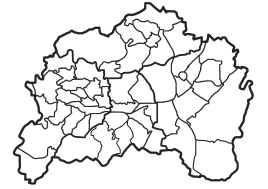Spelsberg hammer
|
Spelsberg hammer
City of Remscheid
Coordinates: 51 ° 12 ′ 1 ″ N , 7 ° 11 ′ 15 ″ E
|
||
|---|---|---|
| Area code : | 02191 | |
|
Location of Spelsberger Hammer in Remscheid |
||
Spelsberger Hammer is a location in the north of the North Rhine-Westphalian city of Remscheid . It is located in the Morsbach valley at an altitude of around 190 meters above sea level . The valley settlement lies below the village of Spelsberg . The Morsbach forms the border between the two districts of Lüttringhausen and Alt-Remscheid .
history
The Spelsberg Hammer Ehlis is said to have been built around 1500. In 1800 the hammer appears as belonging to Peter Josua Hasenclever and Wilhelm Schmitz. In 1828 the Breithammer belongs to Gottfried Halbach zu Spelsberg. In 1836 it was called "Halbacher Hammer", but was already operated by Reinhard Ehlis zu Büchel. 1846 reads: "Steel and wide hammer from C. Ehlis zu Remscheid-Haddenbach, factory built 350 years ago, no concession available, annual production 40,000 pounds." It wasn't until 1910 that Ernst Ehlis had the hammer demolished in Platz. The hammer that opened in the Haddenbacher Lohmühle , later Schumacher & Kissling (Matador factory), also seemed to be ancient . It is referred to as a hammer on the Remscheid side of the stream across from Spelsberg or under the Haddenbacher hammers. In any case, 1623 is the first entry according to which this Reckhammer belongs to Jan in the Haddenbach . After 1804 it was converted into a wage mill. It has a massive quarry stone basement and was converted into a residential building around 1900. The wool merchant Wilhelm Karsch is the owner of this tinder mill. In 1863 he received the license to drive a steam locomotive to operate woolen burdock rollers and wool swiveling machines.

Heinrich Kissling and Heiner Schumacher founded the Schumacher & Kissling company in 1900. They began pounding on two water-powered blacksmiths with the production of pliers, hammers, sockets and bicycle tools. The family-owned company is still at this traditional location today. A group photo from 1909 shows no fewer than 49 people who worked in the company at the time. In 1919 the brand name "Matador", which still exists today, was entered in the commercial register. Numerous patents and utility models were granted over the next few decades. The production program expanded to include special tools for the automotive industry as well as sockets and ratchets. The Matador socket wrench sets emerged from an idea that co-founder Heinrich Kissling brought back from a study trip to the USA. In the sixties to nineties, numerous investments were made to streamline and expand the company. New buildings enlarged the production area. The renovation and expansion of the administration building took place in 1990.
Industrial use
In the area of Spelsberger Hammer, a Spelsberger Hammer and an Ehlieshammer are already mentioned in the late 14th century. They were located on the same reservoir and used the water power of the Morsbach. In 1607, "two grinding knots under Spilsberg, each with a geloep" are mentioned. In the 19th century there were still several hammers and grinding bowls in Spelsberger Hammer. Today the local situation is characterized by medium-sized metalworking companies and a few residential buildings. Up until the last third of the 20th century, a gasometer called a " gas boiler " was in operation on the opposite edge of the valley for many decades .
traffic
The route of the Ronsdorf-Müngstener Railway ran through Spelsberger Hammer , which was opened on this section on November 16, 1891 and was also shut down for freight traffic on August 30, 1959. There were train stations in Clarenbach and Ehligshammer. Today, a city bus line and a citizen bus several times a day operate more sporadically in local public transport .
Web link
Literature and Sources
- Heinrich Rauscher; Historical hike through the Morsbach valley and its side valleys ; 1986; Born-Verlag Wuppertal; ISBN 3-87093-037-3
- Günter Schmidt: "Hammer and Kotten research in Remscheid - from Gerstau to Haddenbach".
- Waterbölles
